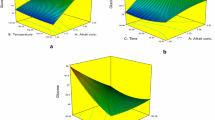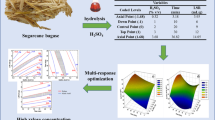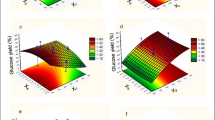Abstract
Sweet sorghum bagasse (SSB) is an agroindustrial waste with a high fiber composition (34–44% cellulose, 25–27% hemicellulose, and 18–20% lignin), widely used in the production of second-generation biofuels. In this study, a response surface design (Box-Behnken) was used to optimize the enzymatic hydrolysis process, using Cellic CTec 3 enzyme. Treatment time (24–72 h), enzyme concentration (5–7% w/w), and liquid solid ratio (LSR) (5–9 v/w) were evaluated to maximize glucose production. The process was optimized both on a dry basis (solar radiation drying after each stage) and on a wet basis (continuous mode). The optimized conditions obtained in the enzymatic hydrolysis on a dry basis were 5% w/w enzyme concentration, 51-h treatment time, and 5: 1 v/w liquid solid ratio (LSR), obtaining 125.2 g/L glucose. For wet basis, the following results were obtained: 5% w/w enzyme concentration, 48-h treatment time, and 5: 1 v/w LSR, obtaining 148.64 g/L glucose. Optimized SSB on a wet basis showed an increase of 18.71% in glucose compared to that obtained on a dry basis, a reduction of 5.88% in process time, and elimination of 96-h solar drying, all of which favor continuous glucose production.



Similar content being viewed by others
References
Ahmed FM, Rahman RS, Gomes DJ (2012) Saccharification of sugarcane bagasse by enzymatic treatment for bioethanol production. Malays J Microbiol 8(2):97–103. https://doi.org/10.21161/mjm.03412
Almodares A, Hadi MR (2009) Production of bioethanol from sweet sorghum: a review. Afr J Agric Res 4(9):772–780 http://www.academicjournals.org/AJAR
Ávila-Lara AI, Camberos-Flores JN, Mendoza-Pérez JA, Messina-Fernández SR, Saldaña-Duran CE, Jimenez-Ruiz EI, Sánchez-Herrera LM, Pérez-Pimienta JA (2015) Optimization of alkaline and dilute acid pretreatment of agave bagasse by response surface methodology. Front Bioeng Biotechnol 3:1–10. https://doi.org/10.3389/fbioe.2015.00146
Barreiro PM (1997) El sorgo mexicano: entre la autosuficiencia y la dependencia externa. Apoyos y Servicios a la Comercialización Agropecuaria (ASERCA). Claridades Agropecu 46:3–13 http://www.infoaserca.gob.mx/claridades/marcos.asp?numero=46
Castañón-Rodríguez JF, Portilla-Arias JA, Aguilar-Uscanga BR, Aguilar-Uscanga MG (2015) Effects of oxygen and nutrients on xylitol and ethanol production in sugar cane bagasse hydrolyzates. Food Sci Biotechnol 24(4):1381–1839. https://doi.org/10.1007/s10068-015-0177-x
Chen C. (2011) Alternative pretreatment of sorghum bagasse for bio-ethanol production. LSU Master’s Theses. Louisiana State University and Agricultural and Mechanical College. Louisiana. EE.UU. https://digitalcommons.lsu.edu/gradschool_theses/2338
Chuck-Hernández C, Pérez-Carrillo E, Heredia-Olea E, Serna-Saldívar S (2011) Sorgo como un cultivo multifacético para la producción de bioetanol en México: tecnologías, avances y áreas de oportunidad. REV MEX ING QUIM 10(3):529–549 http://www.rmiq.org/iqfvp/Pdfs/Vol.%2010%20No.%203/Alim_6/Alim_6.html
DataAgro (2018) Consultoria Agrícola Independiente, www.datagro.com
Fassio A, Cazzolino D, Ibáñez W, Fernández E (2007) Sorgo: destino forrajero. Serie Técnica N° 127. Unidad de Agronegocios y Difusión del Instituto Nacional de Investigación Agropecuaria, Montevideo, Uruguay. http://www.ainfo.inia.uy
Galbe M, Zacchi G (2007) Pretreatment of lignocellulosic materials for efficient bioethanol production. Adv Biochem Eng Biotechnol 108:41–65. https://doi.org/10.1007/102007070
Giorgio EM, Morales A, Congost G, Fonseca MI, Abate C, Zapata PD, Villalba LL (2013) Laboratory evaluation of a submerged system production of endo-l.4-p-glucanase secreted for two strains of white rot fungi. Revista de Ciencia y Tecnología. 19:18–23. http://www.scielo.org.ar/scielo.php?s..
Guarnizo FA, Martínez YPN, Valencia SHA (2009) Pretratamiento de la celulosa y biomasa para la sacarificación. Scientia et technica 42(2):284–289. https://doi.org/10.22517/23447214.2655
Guilherme AA, Dantas PVF, Santos ES, Fernandes FAN, Macedo GR (2015) Evaluation of composition characterization and enzymatic hydrolysis of pretreated sugar cane bagasse. Braz J Chem Eng 32(1):23–33. https://doi.org/10.1590/0104-6632.20150321s00003146
Gutiérrez PH, De La Vara SR (2008) Análisis y diseño de experimentos. 2ª edn. McGraw-Hill, New York, pp 384–420
Hahn-Hägerdal B, Galbe M, Gorwa-Grauslund MF, Lidén G, Zacchi G (2006) Bio-ethanol—the fuel of tomorrow from the residues of today. Trends Biotechnol 24(12):549–556. https://doi.org/10.1016/j.tibtech.2006.10.004
Kim HJ, Kim SB, Kim CJ (2007) The effects of nonionic surfactants on the pretreatment and enzymatic hydrolysis of recycled newspaper. Biotechnol Bioprocess Eng 12(2):147–151. https://doi.org/10.1007/BF03028641
Li W, Du W, Liu D (2007) Optimization of whole cell-catalyzed methanolysis of soybean oil for biodiesel production using response surface methodology. J Mol Catal B Enzym 45:12–127. https://doi.org/10.1016/j.molcatb.2007.01.002
Montes GN, Díaz PG, Loredo PR, González JA, Salinas GJR (2010a) Guía técnica de producción de sorgo dulce [Sorghum bicolor (L.) Moench] in Tamaulipas. Technical Booklet 49, ISBN 978-607-425-468-6. http://biblioteca.inifap.gob.mx:8080/jspui/handle/123456789/2702
Montes, GN, García GMA, Cisneros LME, Pecina QV (2010b) RB. Cañero: sorgo dulce [Sorghum bicolor (L.) Moench] para la producción de etanol. Technical Booklet 41. ISBN: 978–607–425-355-9. http://biblioteca.inifap.gob.mx:8080/jspui/handle/123456789/2715
Nochebuena MLE, Dominguez GCX, López ZL, Aguilar UMAG (2012) Statistical optimization of alkaline hydrogen peroxide pretreatment of sugarcane bagasse for enzymatic saccharification with tween 80 using response surface methodology. Biomass Convers Bior 4(1):15–23. https://doi.org/10.1007/s13399-013-0091-5
O’Hara IM, Kent G, Alberston P, Harrison MD, Hobson P, McKenzie N, Moghaddam L, Moller D, Rainey T, Stolz W, Wong HH, Ellett B (2013) Sweet sorghum: opportunities for a new, renewable fuel and food industry in Australia. Rural Industries Research and Development Corporation, Australia, pp 5–14
Partida-Sedas G, Montes-García N, Carvajal-Zarrabal O, López-Zamora L, Gómez-Rodríguez J, Aguilar-Uscanga MG (2017) Optimization of hydrolysis process to obtain fermentable sugars from sweet Sorghum bagasse using a box–Behnken design. Sugar Tech 19(3):317–325. https://doi.org/10.1007/s12355-016-0461-y
Pernalete Z, Piña F, Suarez M, Ferrer A, Aiello C (2008). Fraccionamiento del bagazo de caña de azúcar mediante tratamiento amoniacal: efecto de la humedad del bagazo y la carga de amoniaco. Bioagro (20)1:3–10. http://www.redalyc.org/articulo.oa?id=85720101
Pin M, Vecchiet A, Picco D (2011) Diffusion of a sustainable EU model to produce 1st generation ethanol from sweet sorghum in decentralised plants: Administrative Manual.[pdf]. Sweethanol project. Intelligent Energy Europe. Centro di Ecologia Teorica ed Applicata (C.E.T.A.), Italia. Disponible en: https://ec.europa.eu/energy/intelligent/projects/sites/iee-projects/files/projects/documents /sweethanol_administrative_manual_en.pdf. Consultado 10 Feb 2017
Prasad S, Singh A, Jain N, Joshi HC (2007) Ethanol production from sweet Sorghum syrup for utilization as automotive fuel in India. Energy Fuel 21(4):2415–2420. https://doi.org/10.1021/ef060328z
Rooney LW, Serna-Saldívar SO (2000) Sorghum. Handbook of Cereal Science and Technology. CRC Press Taylor & Francis Group, Boca Raton, pp 149–176
Serna-Saldivar SO (2010) Cereal grains: properties, processing, and nutritional attributes. CRC press, Boca Raton
Sun JX, Sun XF, Zhao H, Sun RC (2004) Isolation and characterization of cellulose from sugarcane bagasse. Polym Degrad Stab 8(2):331–339. https://doi.org/10.1016/j.polymdegradstab.2004.02.008
Sun RC, Fang JM, Tomkinson J (2000) Delignification of rye straw using hydrogen peroxide. Ind Crop Prod 12(2):71–83. https://doi.org/10.1016/S0926-6690(00)00039-X
Sun Y, Cheng J (2002) Hydrolysis of lignocellulosic materials for ethanol production: a review. Bioresour Technol 83(1):1–11. https://doi.org/10.1016/S0960-8524(01)00212-7
Taylor JRN, Schober TJ, Bean SR (2006) Novel food and non-food uses for sorghum and millets. J Cereal Sci 44(3):252–271. https://doi.org/10.1016/j.jcs.2006.06.009
Van SPJ, Robertson JB, Lewis BA (1991) Methods for dietary fiber, neutral detergent fiber and nonstarch polysaccharides in relation to animal nutrition. J Dairy Sci 74(10):3583–3597. https://doi.org/10.3168/jds.S0022-0302(91)78551-2
Viñals-Verde M, Bell-García A, Michelena-Álvarez G, Ramil-Mesa M (2012) Obtención de etanol a partir de biomasa lignocelulósica. ICIDCA Sobre los derivados de la Caña de Azúcar 46(1):7–16 http://www.redalyc.org/articulo.oa?id=223123848002
Vogel KP, Pedersen JF, Masterson SD, Toy JJ (1999) Evaluation of a filter bag system for NDF, ADF, and IVDMD forage analysis. Crop Sci 39(1):276–279 http://digitalcommons.unl.edu/agronomyfacpub/956
Acknowledgements
The authors acknowledge the critical reading of Patricia Margaret Hayward-Jones, M.Sc., and Dulce María Barradas-Dermitz, M.Sc.
Funding
Economic support was provided by the National Council of Science and Technology and the Secretariat of Agriculture, Livestock, Rural Development, Fisheries and Food, Mexico (CONACyT-SAGARPA, Project 291143).
Author information
Authors and Affiliations
Corresponding author
Additional information
Publisher’s note
Springer Nature remains neutral with regard to jurisdictional claims in published maps and institutional affiliations.
Rights and permissions
About this article
Cite this article
Guarneros-Flores, J., Aguilar-Uscanga, M.G., Morales-Martínez, J.L. et al. Maximization of fermentable sugar production from sweet sorghum bagasse (dry and wet bases) using response surface methodology (RSM). Biomass Conv. Bioref. 9, 633–639 (2019). https://doi.org/10.1007/s13399-018-00366-1
Received:
Accepted:
Published:
Issue Date:
DOI: https://doi.org/10.1007/s13399-018-00366-1




